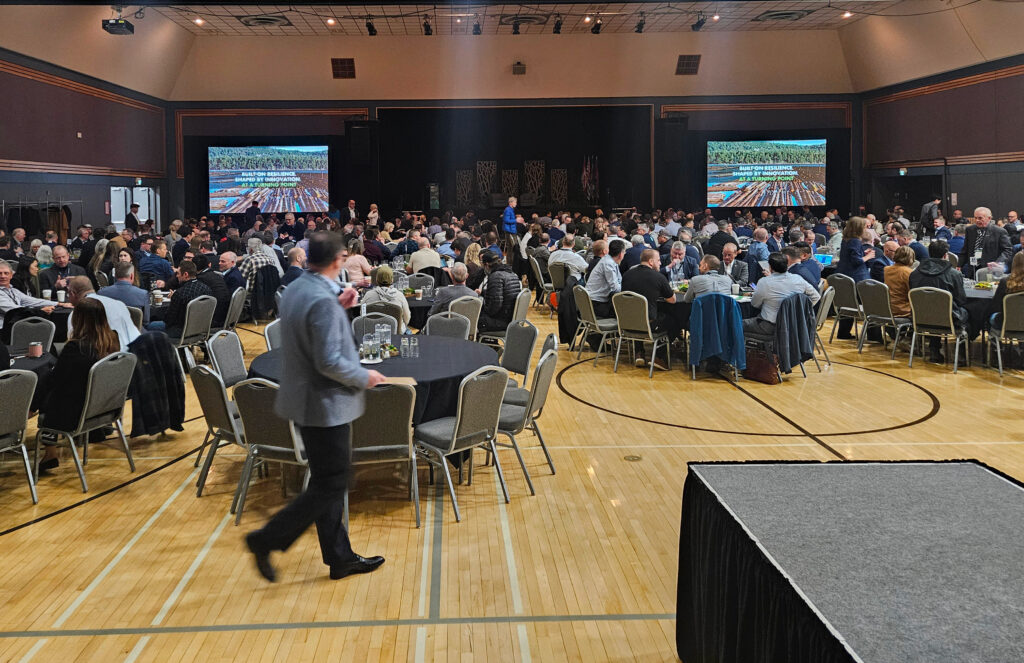A great time was had in Prince George, BC, April 2 – 4 for the annual Council of Forest Industries convention. A jam-packed event of exhibitors and presenters brought 650 participants to the central British Columbia city to discuss the latest development with forestry and the lumber industry across North America:
The theme for this meeting was “Where Do We Stand? Strategies for Competitiveness and Sustainability”. Presenters ranged from economists and policy techs to First Nations and woodlots representatives, with a sizeable showing political leaders.
Much of the discussion over the two days centred around the difficulties for BC forest operators to access fibre. Many presenters talked about the challenges on the ground to gain cutting permits from BC Timber Sales. The presentation by COFI’s own VP & Chief Economist, Kurt Niquidet, captured the audience in rapt attention. Niquidet drew parallels between the availability of merchantable timber in Nordic countries, where there is substantial log harvest from tens of thousands of privately-owned timberlands as small as 10 hectares.
The suggestion is that BC First Nations and woodlots/Community Forests could achieve the same, by becoming forest owner timber suppliers. The next the panel topic was “Rough Waters Ahead: Navigating Global Markets”, where Shawn Lawlor, Managing Director for Canada Wood Japan, explained that Canada Wood has received approval by China Cross-Laminated and Mass Timbers standards for BC Spruce-Pine-Fir.
The Forest Products Association of Canada’s Chief Sustainability Officer and Senior VP, Kate Lindsay, talked about FPAC’s “Roadmap to Bioeconomy” which consists of four main pillars: Creating agile regulation and government policy; Establishing biomass supply and stewardship of natural capital; Building strong companies and value chains; and, Building strong sustainable innovation.

Next up, Tim Caldecott, Senior Director of Sustainable Construction at FPInnovations, presented “New Takes on Hot Buildings” and explained the latest development in engineered wood … making house foundations of out mass timber.
Further along the agenda was a fascinating presentation for the panel “Let’s Talk About Fibre”, discussing predictable access to wood fibre supply. Jennifer Gunter, Executive Director of the BC Community Forest Association, advocated for “getting the right tenure to the right place” in a “process from the ground up”.
Describing fibre supply as a “social license”, Gunter explained that a community forest agreement tenure is a strategy to good community engagement. Gunter continued that community forests have proven success, as they are “one of the highest performers of reaching Annual Allowable Cut levels with actual harvests”.
One example of this is the Pemberton Community Forest and Líl̓wat First Nation. Another example was Burns Lake, BC, which consists of two municipalities and six First Nations who all collaborated to achieve “concrete Annual Allowable Cut”.
Madison’s took special note that the earlier discussion about ample access to fibre in Nordic countries from a large amount of small private timberland owners was similar to this newer conversation about increased real log harvest from combined Community Forests and First Nations’ timberlands.
BC Minister of Forests, the Honourable Ravi Parmar, started his speech by asking if the crowd if they “felt liberated yet” (in reference to the US President’s tariff announcements titled “Liberation Day”) . . . a comment which was met with a solid round of laughter.
Parmer detailed some of the latest new developments at the Ministry of Forests, specifically a review of BC Timber Sales. There are four changes already demonstrated, targetting silviculture and BC Parks, with a strong view toward forest stewardship. As well, changes to BC Timber Sales will now provide permits for fire salvage “within days”.
The Minister acknowledged that “without a healthy primary manufacturing industry the secondaries can’t operate” which drew an enthusiastic round of applause.
British Columbia Premier David Eby delivered the final day luncheon keynote, starting off strong by announcing the Forestry Innovation Directive.
Using a new $10 million in funding, this Directive is tasked with “diversifying BC’s forest products markets internationally”.
As well, transportation regulations have been changed to allow 9-axle trucks on BC roads.
There is also improvement in data collection, with LiDAR scanning to increase.
This new timber supply data will be available publicly.
Finally, the BC government has created a dashboard to track permit applications and increase accountability of delays to greatly reduce the backlogs.
